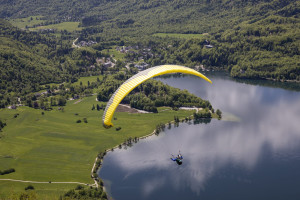Triglav National Park
Triglav National Park is the only national park in Slovenia that protects the last areas of pristine nature in the Alps. A diverse area of the highest peaks of the Julian Alps, their jagged ridges, vertical cliffs, deeply incised valleys, hard-to-reach gorges, wild waters, forests, blankets of alpine flowers, mountain lawns and scree, high-mountain karst, glacial lakes and the tender splendour of biodiversity.
In 1908, at the time of the national struggle between the Slovenes and the Germans, the Slovenian scientist, naturalist and seismologist Dr Albin Belar proposed that the valley of the Triglav Lakes should be protected. This would create the first protected area in the whole of Europe. Despite the fact that the commission evaluated the proposal positively, the idea was not accepted.


In 1924, members of the Slovenian Mountaineering Society and members of the Slovenian Museum Society (Nature Conservation Section) leased 1,400 hectares of land in the Triglav Lakes Valley, thus enabling the creation of the Alpine Conservation Park in the Triglav Lakes Valley (lease agreement). Later proposals to enlarge the park were interrupted by the Second World War. Efforts to restore the park continued after the Second World War, and in 1961 (53 years after Belar’s initiative) a decree was passed declaring the Triglav Lakes Valley a national park (2,000 ha in size). The park is named after the highest mountain, Triglav (2,864 m), while the lowest point is Tolminska korita (180 m).
The Triglav National Park Act, which increased the size of the park to 83,807 ha, was adopted in 1981. In 2010, the new Triglav National Park Act was adopted and the park was enlarged (to include the settlement of Kneške ravne and its surroundings).
Triglav National Park is one of Europe’s oldest parks. It lies in the north-west of Slovenia, on the border with Italy and close to the border with Austria, in the south-eastern part of the Alpine massif. It overlaps almost completely with the Eastern Julian Alps.
The mission of Triglav National Park
- protecting ecosystems and preserving the cultural landscape
- ensuring sustainable development in the park
- making the park enjoyable
- exploration
- educational and training work
Triglav National Park in numbers

- Total: 83,982 ha (4% of Slovenia).
– conservation area 1: 31,488 ha.
– conservation area 2: 32,412 ha.
– conservation area 3: 20,082 ha. - Highest point: Triglav, 2864 m
- Lowest point: Tolminska korita, 180 m
- Number of settlements: 33 (21 fully, 12 partially)
- Population: 2,337 (January 2018)
- The municipalities in the park are Bovec (30.1%), Bohinj (26.3%), Kranjska Gora (16.9%), Bled (1.8%), Tolmin (8.4%), Kobarid (3.7%) Gorje (12.7%) and Jesenice (0.1%).
The municipality of Bohinj accounts for 66% of the Triglav National Park, which also includes Posočje, the Zgornjesavska Valley and Pokljuka.
The Triglav National Park has a total of 1013 natural values, 7 Special Protection Areas (SPA), of which 1 is a Special Area of Conservation (SPA), 6 Potential Conservation Areas (PAC) and 3 Ecologically Important Areas (IBA). By a UNESCO decision of 10 July 2003 Triglav National Park was included in the international network of MAB Biosphere Areas as the Julian Alps Biosphere Area, which covers the wider part of the Julian Alps up to the national borders with Austria and Italy. 24. On May 2004, the Triglav National Park was awarded a Council of Europe Diploma, which was renewed in 2009 for a further 10 years. The Triglav National Park also has 300 immovable cultural heritage units.The Triglav National Park also has 300 Intangible Cultural Heritage units.

Get to know, experience and understand the Triglav National Park with the help of detailed descriptions and useful information you will find on the official Triglav National Park website.
RELATED CONTENT
As more than 60% of Bohinj lies in the central and peripheral area of the Triglav National Park, it is an important element in the shaping and development of the Bohinj tourist destination.
Despite the restrictions imposed by exploring nature in a protected area, the Triglav National Park offers you the ultimate experience.
























